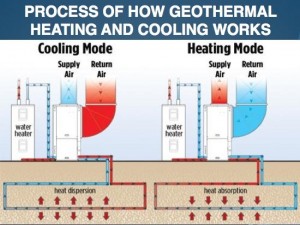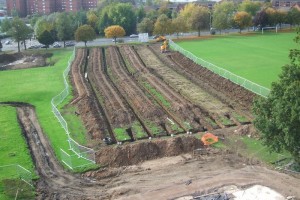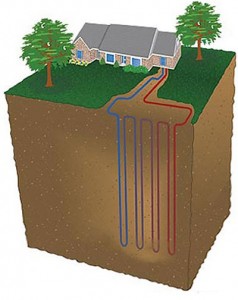- One of the most energy efficient systems currently available
- Can heat and cool sheds
- Almost zero Carbon emissions
- Highly scalable
- Can slash energy costs by 50 to 70%
In the the winter 2013 edition of the Drumstick (a free quarterly newsletter produced by NSW Department of Primary Industries providing information and updates for the poultry industry) Byron wrote an article about Biomass Energy and the potential it had to slash heating costs and to keep litter drier compared to using LPG. That story created quite a bit of interest from growers as well as ‘green’ energy providers – companies providing cheaper and greener energy solutions for a range of industries, including intensive agriculture.
One of the companies Byron spoke with introduced me to the concept of Geothermal Heating and Cooling, also known as Ground Source Heat Pump.
So what exactly is Geothermal Heating and Cooling, and do you need to near hot water springs or a volcano to take advantage of this source of energy?
The answer to the second question is ‘No, you definitely don’t need to be near a source of hot water/mineral springs to take advantage of Geothermal Energy’. The remainder of this article will deal with the first part of the question, i.e. So what exactly is Geothermal Heating and Cooling?
Basically, geothermal heating and cooling involves the use of the constant heat (geothermal energy) that exists approximately 2m to 3m below ground for heating and cooling purposes.

How does it work?
The temperature of the soil at approximately 2 to 3m below the surface remains relatively constant at around 12 to 18o C all year round. A geothermal heating and cooling system is designed to draw on this heat energy using a system of fluid-filled underground pipes called a ‘loop’. The loop absorbs the heat energy in the ground and carries it indoors to a heat pump. The heat pump compresses the heat to a higher temperature and distributes it throughout the shed. In summer, the system reverses, pulling heat from the shed and depositing it back into the ground via the same loop system.
The three main components of a geothermal system consist of:
- the heat and cooling pump (pretty much the same technology as a refrigerator or air conditioning pump), the more common term now is a “heat pump”
- the underground piping system made up of HDPE poly pipe (the loop), and
- the ductwork to distribute the heat.
Let’s have a look at the ‘loop’ part of the system first
The poly pipes which make up the loop can be either:
- closed or
- open and,
- horizontal or
- vertical
An open loop system uses groundwater from an ordinary bore as a heat source. The groundwater is pumped into the heat pump unit where heat is extracted and water is disposed of in an environmentally safe manner. Because groundwater is a relatively constant temperature year round, wells are an excellent heat source.
A closed loop system uses a continuous loop of buried polyethylene pipe (‘poly pipe’). The pipe is connected to the indoor heat pump to form a sealed, underground loop through which an environmentally friendly antifreeze-and-water solution is circulated. A closed loop constantly recirculates it’s heat-transferring solution in a pressurised pipe, unlike an open loop system that consumes water from a bore.
Most closed loops are trenched horizontally in areas adjacent to the sheds. The poly pipes are laid 2 to 3m deep in trenches several hundred feet long (see Figure 2).

If insufficient land is available for trenching, then the loop can also be installed vertically. Holes are bored up to 100m deep. U-shaped loops of pipe are inserted in the holes. The holes are then grouted to ensure consistent ground contact with the earth (see Figure 3).

How does the geothermal heat pump work?
Simply put, a heat pump is a device that uses a small amount of energy to move heat from one location to another. Not too difficult, right? Heat pumps are typically used to pull heat out of the ground to heat the sheds, but they can be reversed to cool sheds as well. In a way, if you know how an air conditioner works, then you already know a lot about how a heat pump works. This is because heat pumps and air conditioners operate in a very similar way.
‘Hold on! You said that the earth is approximately 12°C. My birds need much more heat that that!’
In addition to moving heat from one place to another, heat pumps also boost the temperature from 12°C to over 38 °C. Some commercial units can get to 93 C The heat pump does this using a cycle of evaporation, compression, condensation and expansion. A refrigerant is used as the heat transfer medium which circulates within the heat pump.
The cycle starts as the cold, liquid refrigerant passes through a heat exchanger (evaporator) and absorbs heat from the low-temperature source (fluid from the ground loop). The refrigerant evaporates into a gas as heat is absorbed. The gaseous refrigerant then passes through a compressor where
the refrigerant is pressurized, raising its temperature to more than 82°C. The hot gas then circulates through a refrigerant-to-air heat exchanger where heat is removed and pumped into the shed at about 38°C. When it loses the heat, the refrigerant changes back to a liquid. The liquid is cooled as it passes through an expansion valve and begins the process again. To work as an air conditioner, the system’s flow is reversed.
Scale of heating and cooling – I though these systems were only suitable for small scale application like homes or small businesses?
This technology is highly scalable, meaning that systems are available to heat an average home all the way to large 11,000 square metre buildings. In fact, there are several examples in NSW where geothermal energy is being used quite effectively on a large commercial scale. These include Lithgow Hospital, Macquarie University, Wagga Wagga Civic Centre and many more throughout the rest of Australia. A growing number of residential homes in rural location, the New England and Sothern Highlands.
How efficient is a geothermal system?
Very.
According to the US EPA Geothermal heating and cooling is the most energy efficient method of heating and cooling currently available.
Most geothermal heat pump systems are measured according to their coefficients of performance or COP. It’s a scientific way of determining how much energy the system produces versus how much it uses. Most geothermal pump systems have COPs of 3-4.5. That means that for every dollar of energy used to power the system, $3 to $4.5 of energy is supplied as heat. Using fossil fuel as an example, where a fossil fuel furnace may be 78-98% efficient, a geothermal heat pump is about 500% efficient.
What’s the catch?
The system is clearly very expensive to install and requires a fair size of land in which to lay the horizontal poly pipes (loops) which are required to extract heat from the ground or to return heat to it during the cooling cycle.
Further, the system may still require a supplemental heat source in extremely cold conditions.
Is this technology really feasible for the poultry meat industry in Australia?
At some point the intensive livestock industry is going to have to strongly consider greener more efficient energy sources. Geothermal energy may very well become a very attractive option for new or expanding farms in the near future.
I would like more information please
If you would like more information, use the internet to search for the term ground source heat pump or geothermal. This will provide you with a large range of websites, both private and government, which should give you plenty of bed time reading, or contact us to discuss your move to a true 24/7 renewable energy